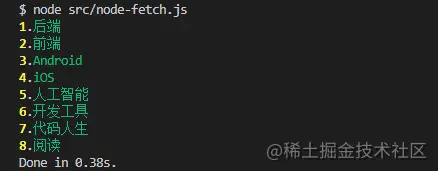
How to initiate an HTTP request in Node.js? This article will explore with you the 6 different methods of Node to initiate HTTP requests. I hope it will be helpful to you!

This article introduces 6 different methods of initiating HTTP requests in nodejs. Here we will use the Nuggets community to The request of the plate classification interface is used as a demonstration to complete the use of each different method. Of course, in order to print out the obtained data more clearly, we need to install the chalk library in advance to print it. Add color to the data, okay, we are about to start~
Node.js is in The standard library comes with an https module, so you don't need to introduce any library to initiate requests, because node.js can do it by itself, and it is more than enough to handle some simple data requests.
const chalk = require("chalk")
const https = require('https')
https.get('https://api.juejin.cn/tag_api/v1/query_category_briefs', res => {
let list = [];
res.on('data', chunk => {
list.push(chunk);
});
res.on('end', () => {
const { data } = JSON.parse(Buffer.concat(list).toString());
data.forEach(item => {
console.log(`${chalk.yellow.bold(item.rank)}.${chalk.green(item.category_name)}`);
})
});
}).on('error', err => {
console.log('Error: ', err.message);
});The structure is a little complicated, because we need to make an empty array list to store the request data block chunk, and then after the request is completed, the data must be processed through the Buffer and then parsed into json format.
I believe that front-end friends are no strangers to axios, it is a very popular And the popular Promise request library. It can be used on both the browser and the client, and as we all know, it also has very convenient functions such as interceptors and automatic data conversion to json.
We can use the following command to install axios:
npm i -S axios
The following is a simple example of how we obtain the Nuggets plate classification through axios:
const chalk = require("chalk")
const axios = require('axios');
axios.get('https://api.juejin.cn/tag_api/v1/query_category_briefs')
.then(res => {
const { data } = res.data
data.forEach(item => {
console.log(`${chalk.yellow.bold(item.rank)}.${chalk.green(item.category_name)}`);
})
})
.catch(err => {
console.log('Error: ', err.message);
});Here axios directly uses the get request to request the interface. The structure can also be in the form of promise, and the data is automatically parsed into json for you, which can be said to be very simple and convenient.
got claims to be “a user-friendly and powerful HTTP request for Node.js "Library" is user-friendly because it uses Promise-style APIs and JOSN processing configuration functions. However, some capabilities such as HTTP2 support, paging API and RFC caching are not available in most request libraries.
We can use the following command to install got:
npm i -S got@10.7.0
The following is a simple example of how we get the Nuggets plate classification through got:
const chalk = require("chalk")
const got = require('got');
got.get('https://api.juejin.cn/tag_api/v1/query_category_briefs', {
responseType: 'json'
})
.then(res => {
const { data } = res.body
data.forEach(item => {
console.log(`${chalk.yellow.bold(item.rank)}.${chalk.green(item.category_name)}`);
})
})
.catch(err => {
console.log('Error: ', err.message);
});Here we first need to configure the request interface {responseType: 'json'}, and then the returned data can be obtained in the body, which is also very easy to use.
We can use the following command to install needle:
npm i -S needle
The following is a simple example of how we obtain the Nuggets section classification through needle:
const chalk = require("chalk")
const needle = require('needle');
needle.get('https://api.juejin.cn/tag_api/v1/query_category_briefs', (err, res) => {
if (err) return console.log('Error: ', err.message);
const { data } = res.body
data.forEach(item => {
console.log(`${chalk.yellow.bold(item.rank)}.${chalk.green(item.category_name)}`);
})
})needle('get', 'https://api.juejin.cn/tag_api/v1/query_category_briefs')
.then(function(res) {
// ...
})
.catch(function(err) {
// ...
});We can use the following command to install superagent:
npm i -S superagent
The following is a simple example of how we obtain the Nuggets plate classification through superagent:
const chalk = require("chalk")
const superagent = require('superagent');
superagent.get('https://api.juejin.cn/tag_api/v1/query_category_briefs')
.then(res => {
const { data } = JSON.parse(res.text)
data.forEach(item => {
console.log(`${chalk.yellow.bold(item.rank)}.${chalk.green(item.category_name)}`);
})
})
.catch(err => {
console.log('Error: ', err.message);
});顾名思义,这个请求库它的api与window.fetch保持了一致,也是promise式的。最近非常受欢迎,但可能最大的问题是,它的v2与v3版差异比较大,v2保持着cjs标准,而v3则用了ejs的方式,升级后可能造成一些困扰,所以为了统一这个标准我们这里用了2.6.7版作为演示版本。
我们可以使用以下命令安装node-fetch:
npm i -S node-fetch@2.6.7
下面是我们通过node-fetch获取掘金板块分类简单示例:
const chalk = require("chalk")
const fetch = require("node-fetch")
fetch('https://api.juejin.cn/tag_api/v1/query_category_briefs', {
method: 'GET'
})
.then(async res => {
let { data } = await res.json()
data.forEach(item => {
console.log(`${chalk.yellow.bold(item.rank)}.${chalk.green(item.category_name)}`);
})
})
.catch(err => {
console.log('Error: ', err.message);
});可以看出它与window.fetch用起来完全一样,没有任何学习压力。

接下来我们看一下关于这几款请求库近一年的下载量趋势图:

现在我们可以发现,就下载量而言,在过去一年中,node-fetch 最受欢迎,needle 最不受欢迎。
| Stars | Version | Unpacked Size | Created Years | |
|---|---|---|---|---|
| axios | 91,642 | 0.26.1 | 398 kB | 2014 |
| got | 10,736 | 12.0.1 | 244 kB | 2014 |
| needle | 1,446 | 3.0.0 | 227 kB | 2012 |
| superagent | 15,928 | 7.1.1 | 581 kB | 2011 |
| node-fetch | 7,434 | 3.2.3 | 106 kB | 2015 |
这里我们又统计了这几个库的其他一些数据,axios的star数量可谓一骑绝尘,远远超过其他几个库。
这些请求库,他们都做了同一件事都可以发起HTTP请求,或许写法会有些许不同,但都是条条大路通罗马。就个人而言,也可能是经常写浏览器端的缘故,所以是axios的忠实用户,不管是练习还是开发axios都是首选,当然node-fetch也越来越收到关注,包也十分的小,练习的时候也会经常用到,但api使用起来感觉还是没有axios那般方便。
其实还有两个出名的HTTP请求库本文没有提到:
一个是ky.js,它是一个非常小巧且强大的fetch式的请求库,主要为deno和现代浏览器所打造,所以暂时不参与其中的讨论,感兴趣的同学自己探索。
另一个就是request.js,没有说的原因是它在2020年的时候就已经被完全弃用了,如果有使用过的小伙伴可以在把项目里的request它替换成其他的方法。
本文转载自:https://juejin.cn/post/7074749427637813284
作者:jsmask
更多node相关知识,请访问:nodejs 教程!
The above is the detailed content of How to initiate HTTP request in Node.js? Brief analysis of 6 methods. For more information, please follow other related articles on the PHP Chinese website!